Smart Cities: Concept, Challenges, and Importance of IoT and Wireless Technology
VerifiedAdded on 2023/06/03
|11
|3728
|278
AI Summary
This essay describes the concept of smart cities and the challenges faced by IoT in smart cities. It also highlights the importance of information technology like IoT and wireless in smart cities with their issues.
Contribute Materials
Your contribution can guide someone’s learning journey. Share your
documents today.

Smart Cities
Secure Best Marks with AI Grader
Need help grading? Try our AI Grader for instant feedback on your assignments.
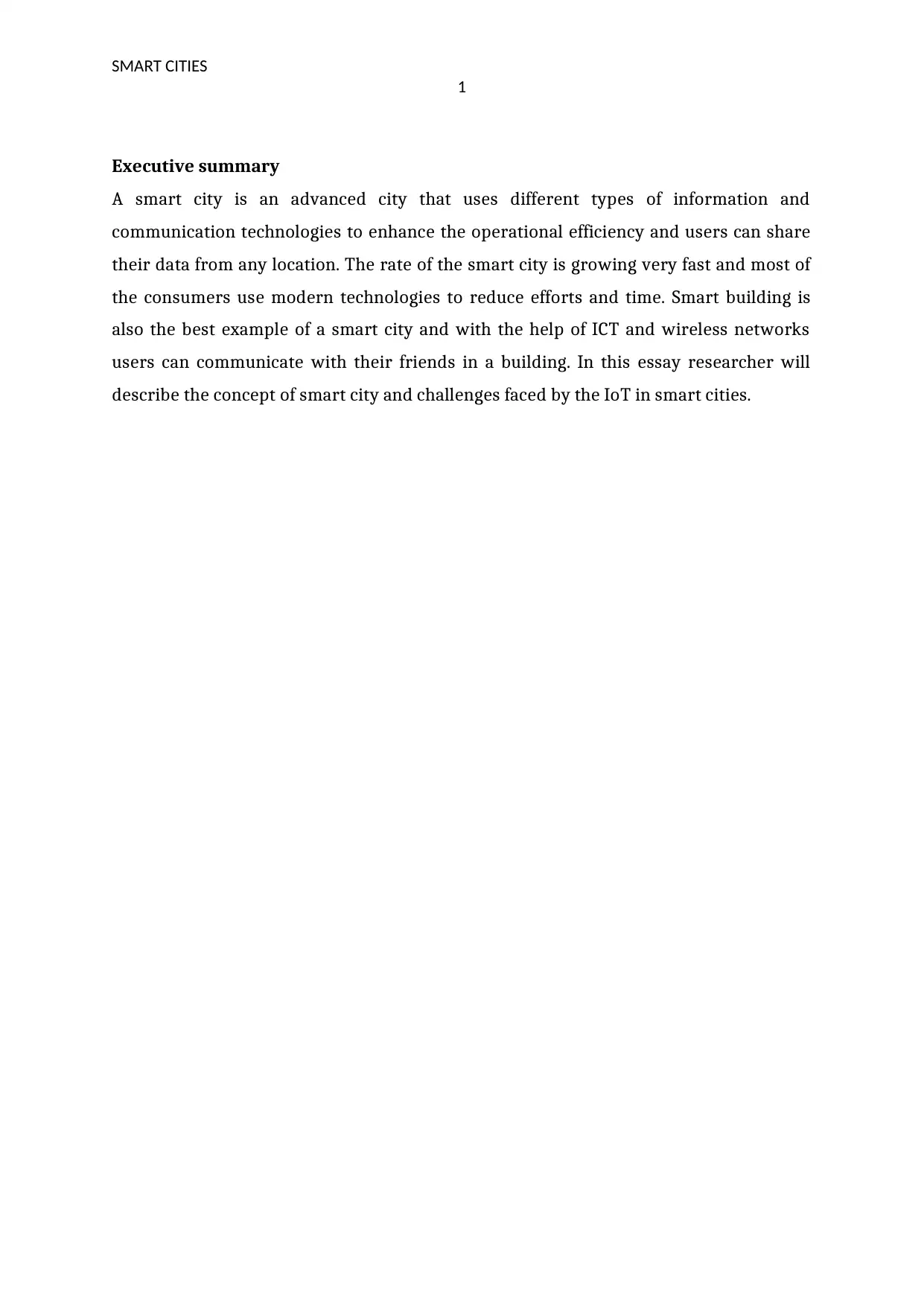
SMART CITIES
1
Executive summary
A smart city is an advanced city that uses different types of information and
communication technologies to enhance the operational efficiency and users can share
their data from any location. The rate of the smart city is growing very fast and most of
the consumers use modern technologies to reduce efforts and time. Smart building is
also the best example of a smart city and with the help of ICT and wireless networks
users can communicate with their friends in a building. In this essay researcher will
describe the concept of smart city and challenges faced by the IoT in smart cities.
1
Executive summary
A smart city is an advanced city that uses different types of information and
communication technologies to enhance the operational efficiency and users can share
their data from any location. The rate of the smart city is growing very fast and most of
the consumers use modern technologies to reduce efforts and time. Smart building is
also the best example of a smart city and with the help of ICT and wireless networks
users can communicate with their friends in a building. In this essay researcher will
describe the concept of smart city and challenges faced by the IoT in smart cities.
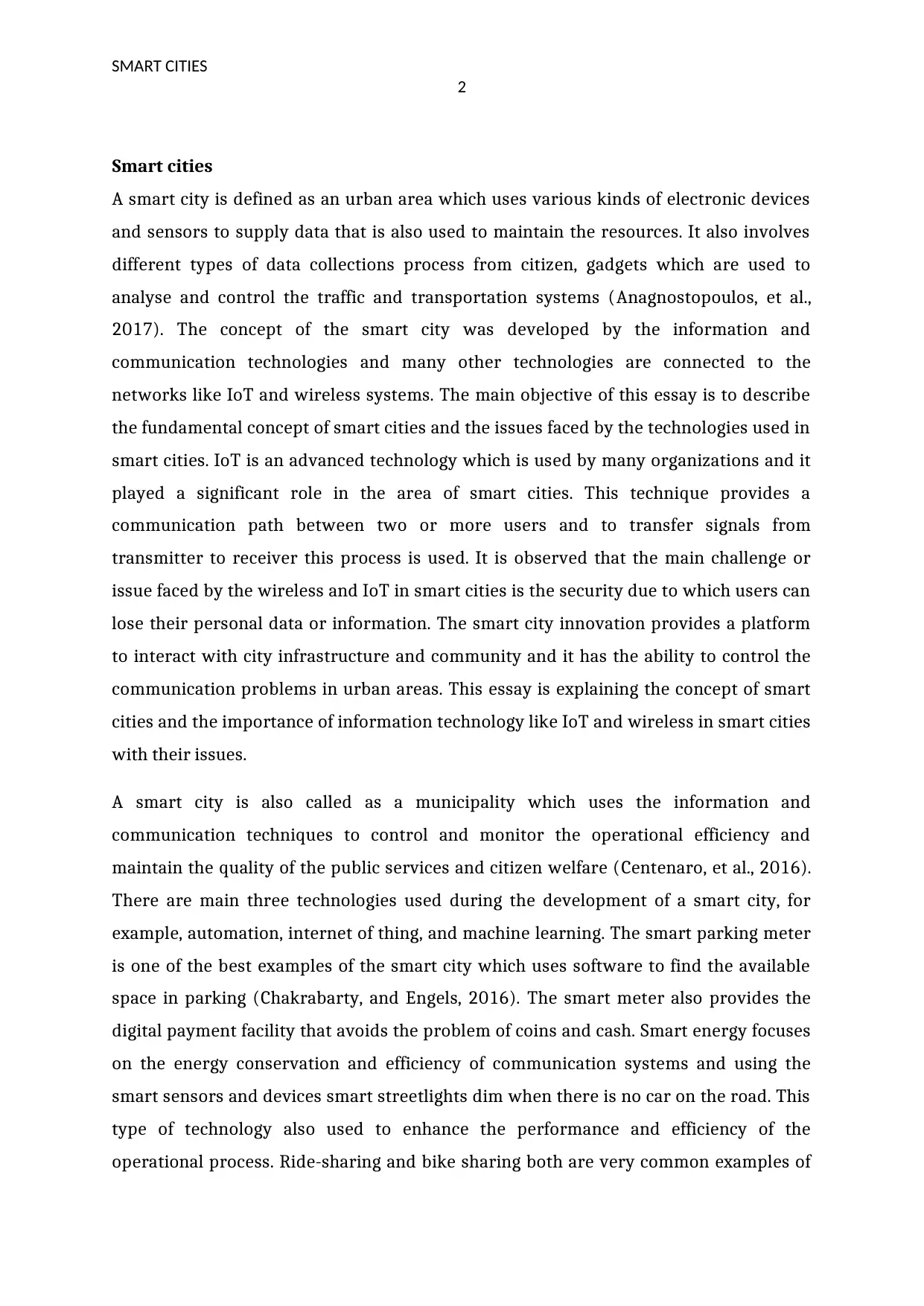
SMART CITIES
2
Smart cities
A smart city is defined as an urban area which uses various kinds of electronic devices
and sensors to supply data that is also used to maintain the resources. It also involves
different types of data collections process from citizen, gadgets which are used to
analyse and control the traffic and transportation systems (Anagnostopoulos, et al.,
2017). The concept of the smart city was developed by the information and
communication technologies and many other technologies are connected to the
networks like IoT and wireless systems. The main objective of this essay is to describe
the fundamental concept of smart cities and the issues faced by the technologies used in
smart cities. IoT is an advanced technology which is used by many organizations and it
played a significant role in the area of smart cities. This technique provides a
communication path between two or more users and to transfer signals from
transmitter to receiver this process is used. It is observed that the main challenge or
issue faced by the wireless and IoT in smart cities is the security due to which users can
lose their personal data or information. The smart city innovation provides a platform
to interact with city infrastructure and community and it has the ability to control the
communication problems in urban areas. This essay is explaining the concept of smart
cities and the importance of information technology like IoT and wireless in smart cities
with their issues.
A smart city is also called as a municipality which uses the information and
communication techniques to control and monitor the operational efficiency and
maintain the quality of the public services and citizen welfare (Centenaro, et al., 2016).
There are main three technologies used during the development of a smart city, for
example, automation, internet of thing, and machine learning. The smart parking meter
is one of the best examples of the smart city which uses software to find the available
space in parking (Chakrabarty, and Engels, 2016). The smart meter also provides the
digital payment facility that avoids the problem of coins and cash. Smart energy focuses
on the energy conservation and efficiency of communication systems and using the
smart sensors and devices smart streetlights dim when there is no car on the road. This
type of technology also used to enhance the performance and efficiency of the
operational process. Ride-sharing and bike sharing both are very common examples of
2
Smart cities
A smart city is defined as an urban area which uses various kinds of electronic devices
and sensors to supply data that is also used to maintain the resources. It also involves
different types of data collections process from citizen, gadgets which are used to
analyse and control the traffic and transportation systems (Anagnostopoulos, et al.,
2017). The concept of the smart city was developed by the information and
communication technologies and many other technologies are connected to the
networks like IoT and wireless systems. The main objective of this essay is to describe
the fundamental concept of smart cities and the issues faced by the technologies used in
smart cities. IoT is an advanced technology which is used by many organizations and it
played a significant role in the area of smart cities. This technique provides a
communication path between two or more users and to transfer signals from
transmitter to receiver this process is used. It is observed that the main challenge or
issue faced by the wireless and IoT in smart cities is the security due to which users can
lose their personal data or information. The smart city innovation provides a platform
to interact with city infrastructure and community and it has the ability to control the
communication problems in urban areas. This essay is explaining the concept of smart
cities and the importance of information technology like IoT and wireless in smart cities
with their issues.
A smart city is also called as a municipality which uses the information and
communication techniques to control and monitor the operational efficiency and
maintain the quality of the public services and citizen welfare (Centenaro, et al., 2016).
There are main three technologies used during the development of a smart city, for
example, automation, internet of thing, and machine learning. The smart parking meter
is one of the best examples of the smart city which uses software to find the available
space in parking (Chakrabarty, and Engels, 2016). The smart meter also provides the
digital payment facility that avoids the problem of coins and cash. Smart energy focuses
on the energy conservation and efficiency of communication systems and using the
smart sensors and devices smart streetlights dim when there is no car on the road. This
type of technology also used to enhance the performance and efficiency of the
operational process. Ride-sharing and bike sharing both are very common examples of
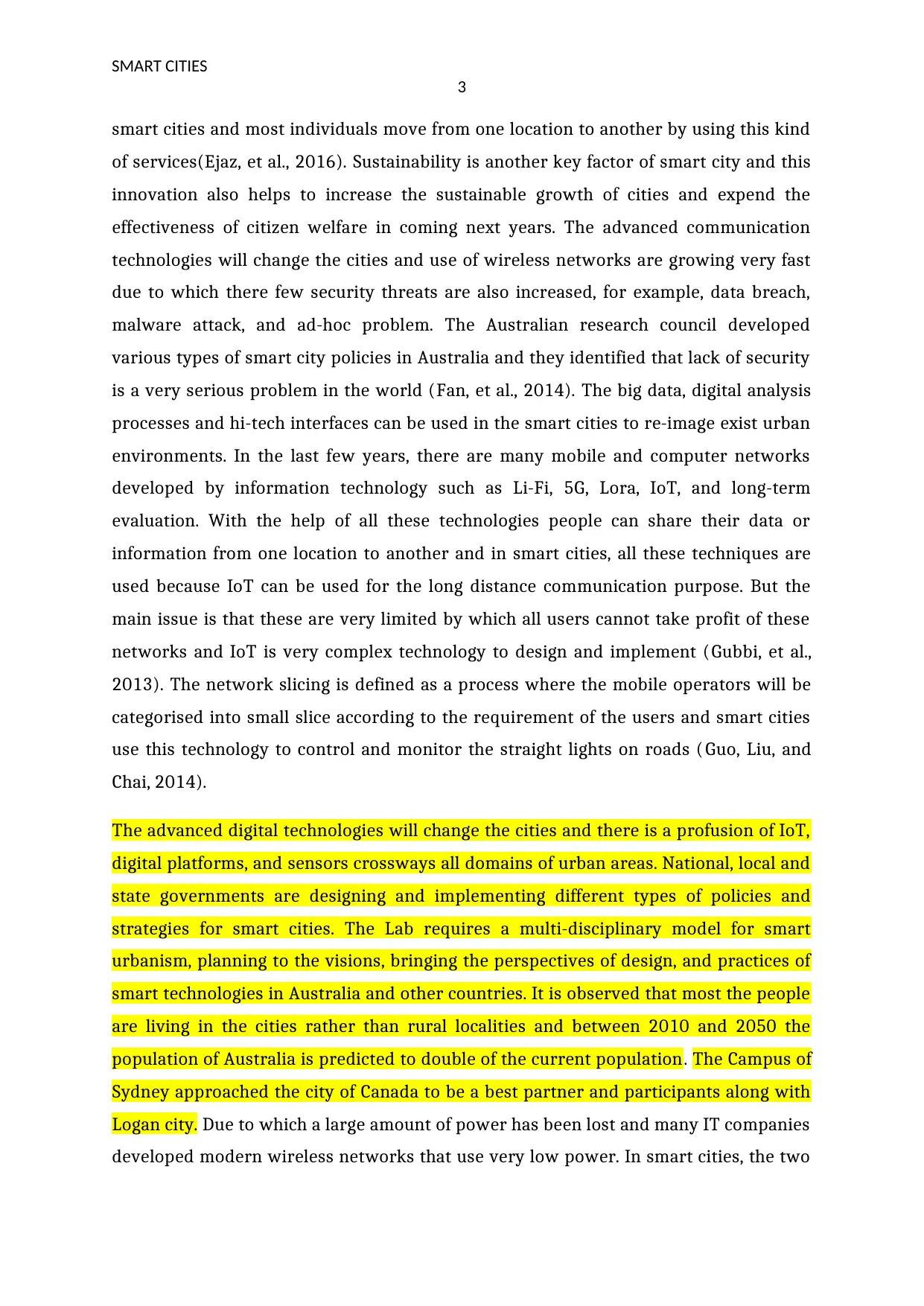
SMART CITIES
3
smart cities and most individuals move from one location to another by using this kind
of services(Ejaz, et al., 2016). Sustainability is another key factor of smart city and this
innovation also helps to increase the sustainable growth of cities and expend the
effectiveness of citizen welfare in coming next years. The advanced communication
technologies will change the cities and use of wireless networks are growing very fast
due to which there few security threats are also increased, for example, data breach,
malware attack, and ad-hoc problem. The Australian research council developed
various types of smart city policies in Australia and they identified that lack of security
is a very serious problem in the world (Fan, et al., 2014). The big data, digital analysis
processes and hi-tech interfaces can be used in the smart cities to re-image exist urban
environments. In the last few years, there are many mobile and computer networks
developed by information technology such as Li-Fi, 5G, Lora, IoT, and long-term
evaluation. With the help of all these technologies people can share their data or
information from one location to another and in smart cities, all these techniques are
used because IoT can be used for the long distance communication purpose. But the
main issue is that these are very limited by which all users cannot take profit of these
networks and IoT is very complex technology to design and implement (Gubbi, et al.,
2013). The network slicing is defined as a process where the mobile operators will be
categorised into small slice according to the requirement of the users and smart cities
use this technology to control and monitor the straight lights on roads (Guo, Liu, and
Chai, 2014).
The advanced digital technologies will change the cities and there is a profusion of IoT,
digital platforms, and sensors crossways all domains of urban areas. National, local and
state governments are designing and implementing different types of policies and
strategies for smart cities. The Lab requires a multi-disciplinary model for smart
urbanism, planning to the visions, bringing the perspectives of design, and practices of
smart technologies in Australia and other countries. It is observed that most the people
are living in the cities rather than rural localities and between 2010 and 2050 the
population of Australia is predicted to double of the current population. The Campus of
Sydney approached the city of Canada to be a best partner and participants along with
Logan city. Due to which a large amount of power has been lost and many IT companies
developed modern wireless networks that use very low power. In smart cities, the two
3
smart cities and most individuals move from one location to another by using this kind
of services(Ejaz, et al., 2016). Sustainability is another key factor of smart city and this
innovation also helps to increase the sustainable growth of cities and expend the
effectiveness of citizen welfare in coming next years. The advanced communication
technologies will change the cities and use of wireless networks are growing very fast
due to which there few security threats are also increased, for example, data breach,
malware attack, and ad-hoc problem. The Australian research council developed
various types of smart city policies in Australia and they identified that lack of security
is a very serious problem in the world (Fan, et al., 2014). The big data, digital analysis
processes and hi-tech interfaces can be used in the smart cities to re-image exist urban
environments. In the last few years, there are many mobile and computer networks
developed by information technology such as Li-Fi, 5G, Lora, IoT, and long-term
evaluation. With the help of all these technologies people can share their data or
information from one location to another and in smart cities, all these techniques are
used because IoT can be used for the long distance communication purpose. But the
main issue is that these are very limited by which all users cannot take profit of these
networks and IoT is very complex technology to design and implement (Gubbi, et al.,
2013). The network slicing is defined as a process where the mobile operators will be
categorised into small slice according to the requirement of the users and smart cities
use this technology to control and monitor the straight lights on roads (Guo, Liu, and
Chai, 2014).
The advanced digital technologies will change the cities and there is a profusion of IoT,
digital platforms, and sensors crossways all domains of urban areas. National, local and
state governments are designing and implementing different types of policies and
strategies for smart cities. The Lab requires a multi-disciplinary model for smart
urbanism, planning to the visions, bringing the perspectives of design, and practices of
smart technologies in Australia and other countries. It is observed that most the people
are living in the cities rather than rural localities and between 2010 and 2050 the
population of Australia is predicted to double of the current population. The Campus of
Sydney approached the city of Canada to be a best partner and participants along with
Logan city. Due to which a large amount of power has been lost and many IT companies
developed modern wireless networks that use very low power. In smart cities, the two
Secure Best Marks with AI Grader
Need help grading? Try our AI Grader for instant feedback on your assignments.
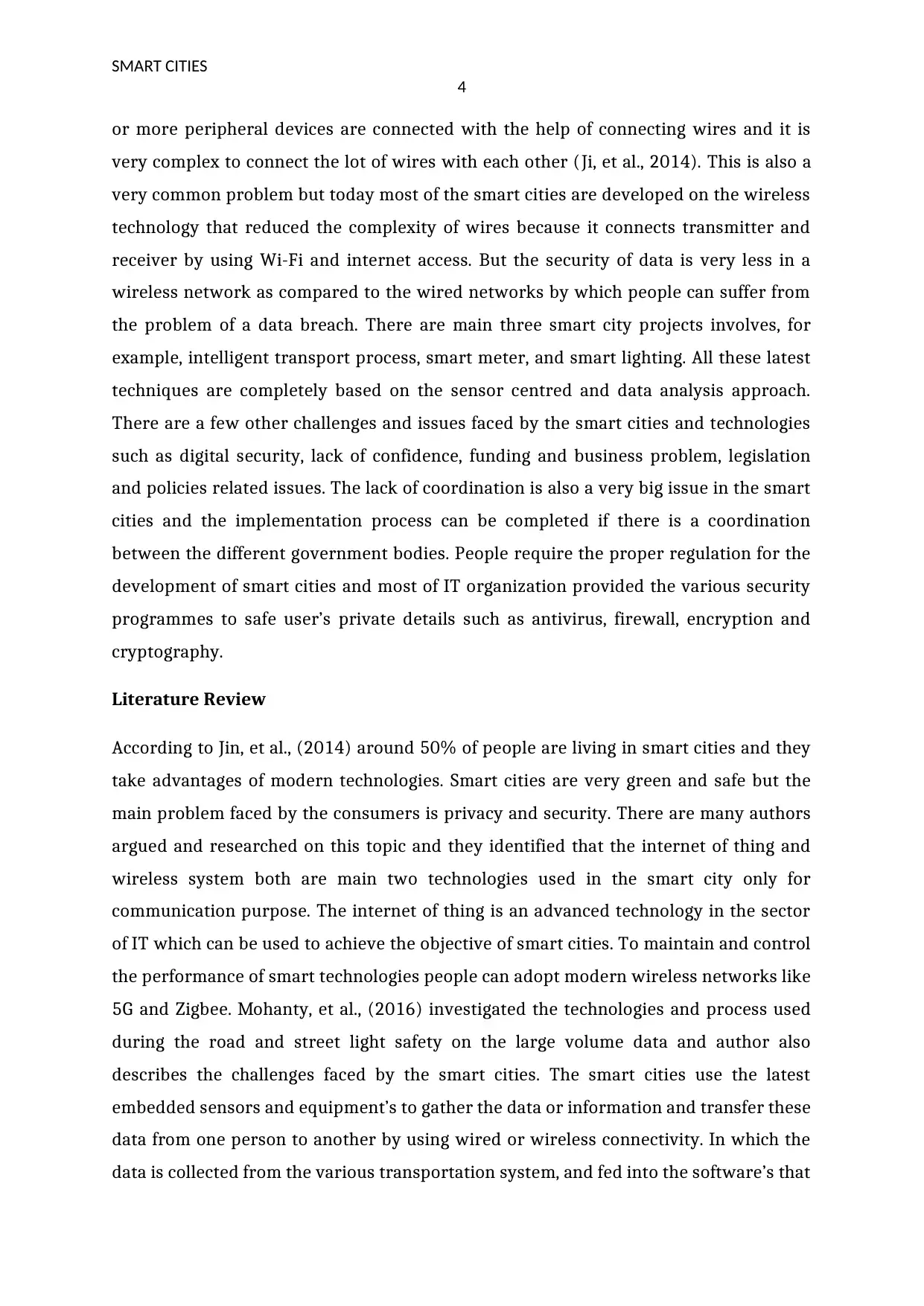
SMART CITIES
4
or more peripheral devices are connected with the help of connecting wires and it is
very complex to connect the lot of wires with each other (Ji, et al., 2014). This is also a
very common problem but today most of the smart cities are developed on the wireless
technology that reduced the complexity of wires because it connects transmitter and
receiver by using Wi-Fi and internet access. But the security of data is very less in a
wireless network as compared to the wired networks by which people can suffer from
the problem of a data breach. There are main three smart city projects involves, for
example, intelligent transport process, smart meter, and smart lighting. All these latest
techniques are completely based on the sensor centred and data analysis approach.
There are a few other challenges and issues faced by the smart cities and technologies
such as digital security, lack of confidence, funding and business problem, legislation
and policies related issues. The lack of coordination is also a very big issue in the smart
cities and the implementation process can be completed if there is a coordination
between the different government bodies. People require the proper regulation for the
development of smart cities and most of IT organization provided the various security
programmes to safe user’s private details such as antivirus, firewall, encryption and
cryptography.
Literature Review
According to Jin, et al., (2014) around 50% of people are living in smart cities and they
take advantages of modern technologies. Smart cities are very green and safe but the
main problem faced by the consumers is privacy and security. There are many authors
argued and researched on this topic and they identified that the internet of thing and
wireless system both are main two technologies used in the smart city only for
communication purpose. The internet of thing is an advanced technology in the sector
of IT which can be used to achieve the objective of smart cities. To maintain and control
the performance of smart technologies people can adopt modern wireless networks like
5G and Zigbee. Mohanty, et al., (2016) investigated the technologies and process used
during the road and street light safety on the large volume data and author also
describes the challenges faced by the smart cities. The smart cities use the latest
embedded sensors and equipment’s to gather the data or information and transfer these
data from one person to another by using wired or wireless connectivity. In which the
data is collected from the various transportation system, and fed into the software’s that
4
or more peripheral devices are connected with the help of connecting wires and it is
very complex to connect the lot of wires with each other (Ji, et al., 2014). This is also a
very common problem but today most of the smart cities are developed on the wireless
technology that reduced the complexity of wires because it connects transmitter and
receiver by using Wi-Fi and internet access. But the security of data is very less in a
wireless network as compared to the wired networks by which people can suffer from
the problem of a data breach. There are main three smart city projects involves, for
example, intelligent transport process, smart meter, and smart lighting. All these latest
techniques are completely based on the sensor centred and data analysis approach.
There are a few other challenges and issues faced by the smart cities and technologies
such as digital security, lack of confidence, funding and business problem, legislation
and policies related issues. The lack of coordination is also a very big issue in the smart
cities and the implementation process can be completed if there is a coordination
between the different government bodies. People require the proper regulation for the
development of smart cities and most of IT organization provided the various security
programmes to safe user’s private details such as antivirus, firewall, encryption and
cryptography.
Literature Review
According to Jin, et al., (2014) around 50% of people are living in smart cities and they
take advantages of modern technologies. Smart cities are very green and safe but the
main problem faced by the consumers is privacy and security. There are many authors
argued and researched on this topic and they identified that the internet of thing and
wireless system both are main two technologies used in the smart city only for
communication purpose. The internet of thing is an advanced technology in the sector
of IT which can be used to achieve the objective of smart cities. To maintain and control
the performance of smart technologies people can adopt modern wireless networks like
5G and Zigbee. Mohanty, et al., (2016) investigated the technologies and process used
during the road and street light safety on the large volume data and author also
describes the challenges faced by the smart cities. The smart cities use the latest
embedded sensors and equipment’s to gather the data or information and transfer these
data from one person to another by using wired or wireless connectivity. In which the
data is collected from the various transportation system, and fed into the software’s that
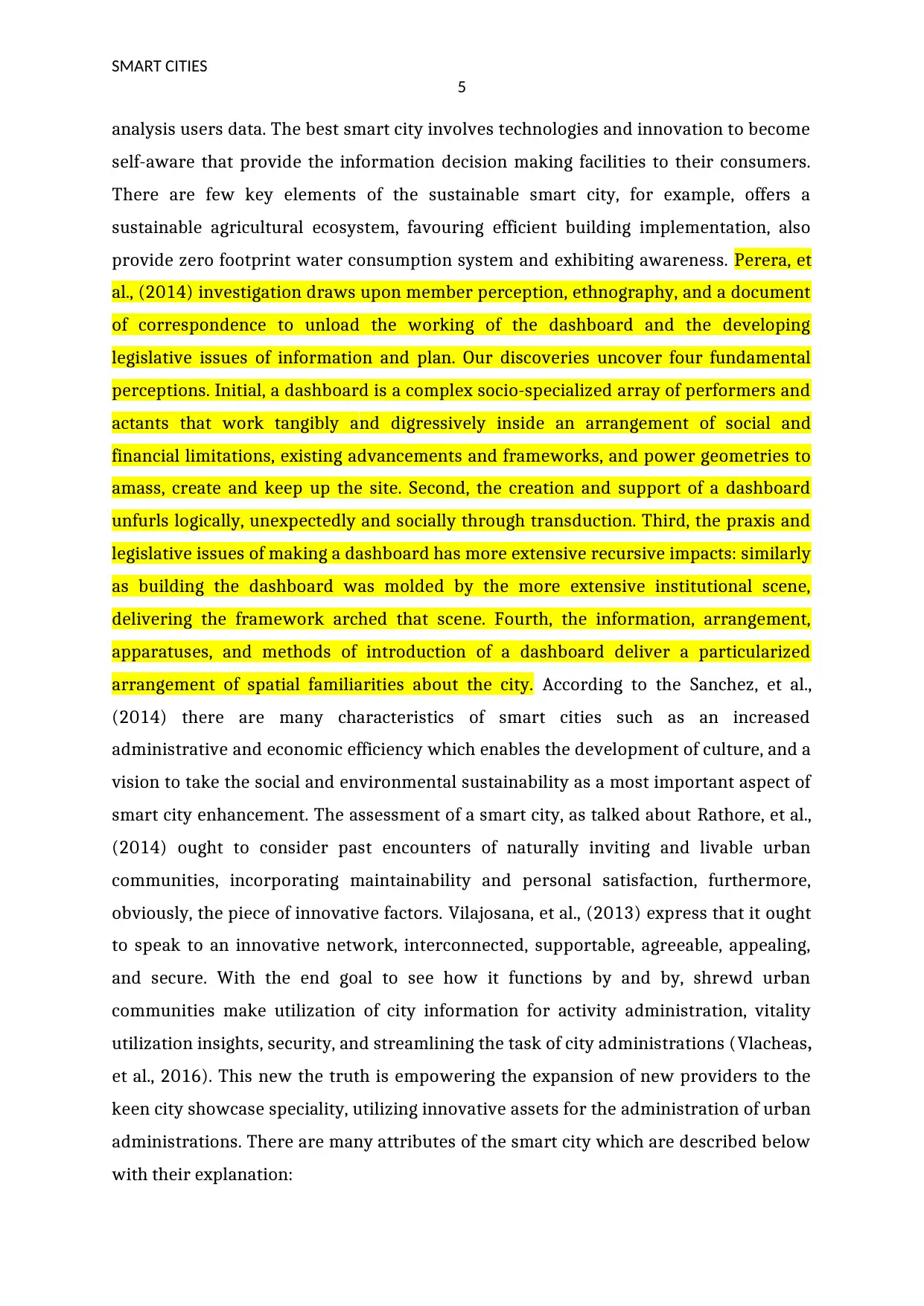
SMART CITIES
5
analysis users data. The best smart city involves technologies and innovation to become
self-aware that provide the information decision making facilities to their consumers.
There are few key elements of the sustainable smart city, for example, offers a
sustainable agricultural ecosystem, favouring efficient building implementation, also
provide zero footprint water consumption system and exhibiting awareness. Perera, et
al., (2014) investigation draws upon member perception, ethnography, and a document
of correspondence to unload the working of the dashboard and the developing
legislative issues of information and plan. Our discoveries uncover four fundamental
perceptions. Initial, a dashboard is a complex socio-specialized array of performers and
actants that work tangibly and digressively inside an arrangement of social and
financial limitations, existing advancements and frameworks, and power geometries to
amass, create and keep up the site. Second, the creation and support of a dashboard
unfurls logically, unexpectedly and socially through transduction. Third, the praxis and
legislative issues of making a dashboard has more extensive recursive impacts: similarly
as building the dashboard was molded by the more extensive institutional scene,
delivering the framework arched that scene. Fourth, the information, arrangement,
apparatuses, and methods of introduction of a dashboard deliver a particularized
arrangement of spatial familiarities about the city. According to the Sanchez, et al.,
(2014) there are many characteristics of smart cities such as an increased
administrative and economic efficiency which enables the development of culture, and a
vision to take the social and environmental sustainability as a most important aspect of
smart city enhancement. The assessment of a smart city, as talked about Rathore, et al.,
(2014) ought to consider past encounters of naturally inviting and livable urban
communities, incorporating maintainability and personal satisfaction, furthermore,
obviously, the piece of innovative factors. Vilajosana, et al., (2013) express that it ought
to speak to an innovative network, interconnected, supportable, agreeable, appealing,
and secure. With the end goal to see how it functions by and by, shrewd urban
communities make utilization of city information for activity administration, vitality
utilization insights, security, and streamlining the task of city administrations (Vlacheas,
et al., 2016). This new the truth is empowering the expansion of new providers to the
keen city showcase speciality, utilizing innovative assets for the administration of urban
administrations. There are many attributes of the smart city which are described below
with their explanation:
5
analysis users data. The best smart city involves technologies and innovation to become
self-aware that provide the information decision making facilities to their consumers.
There are few key elements of the sustainable smart city, for example, offers a
sustainable agricultural ecosystem, favouring efficient building implementation, also
provide zero footprint water consumption system and exhibiting awareness. Perera, et
al., (2014) investigation draws upon member perception, ethnography, and a document
of correspondence to unload the working of the dashboard and the developing
legislative issues of information and plan. Our discoveries uncover four fundamental
perceptions. Initial, a dashboard is a complex socio-specialized array of performers and
actants that work tangibly and digressively inside an arrangement of social and
financial limitations, existing advancements and frameworks, and power geometries to
amass, create and keep up the site. Second, the creation and support of a dashboard
unfurls logically, unexpectedly and socially through transduction. Third, the praxis and
legislative issues of making a dashboard has more extensive recursive impacts: similarly
as building the dashboard was molded by the more extensive institutional scene,
delivering the framework arched that scene. Fourth, the information, arrangement,
apparatuses, and methods of introduction of a dashboard deliver a particularized
arrangement of spatial familiarities about the city. According to the Sanchez, et al.,
(2014) there are many characteristics of smart cities such as an increased
administrative and economic efficiency which enables the development of culture, and a
vision to take the social and environmental sustainability as a most important aspect of
smart city enhancement. The assessment of a smart city, as talked about Rathore, et al.,
(2014) ought to consider past encounters of naturally inviting and livable urban
communities, incorporating maintainability and personal satisfaction, furthermore,
obviously, the piece of innovative factors. Vilajosana, et al., (2013) express that it ought
to speak to an innovative network, interconnected, supportable, agreeable, appealing,
and secure. With the end goal to see how it functions by and by, shrewd urban
communities make utilization of city information for activity administration, vitality
utilization insights, security, and streamlining the task of city administrations (Vlacheas,
et al., 2016). This new the truth is empowering the expansion of new providers to the
keen city showcase speciality, utilizing innovative assets for the administration of urban
administrations. There are many attributes of the smart city which are described below
with their explanation:
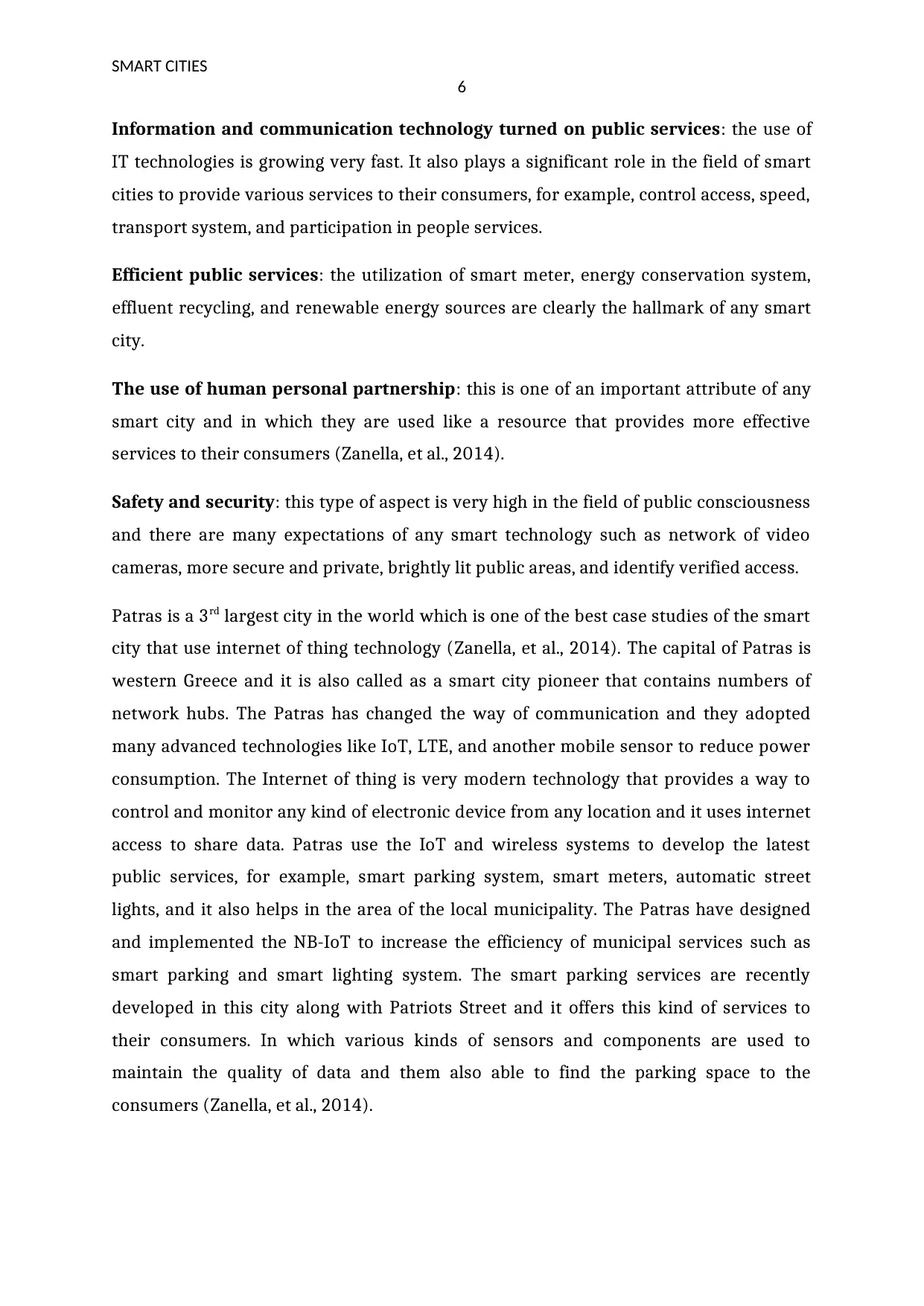
SMART CITIES
6
Information and communication technology turned on public services: the use of
IT technologies is growing very fast. It also plays a significant role in the field of smart
cities to provide various services to their consumers, for example, control access, speed,
transport system, and participation in people services.
Efficient public services: the utilization of smart meter, energy conservation system,
effluent recycling, and renewable energy sources are clearly the hallmark of any smart
city.
The use of human personal partnership: this is one of an important attribute of any
smart city and in which they are used like a resource that provides more effective
services to their consumers (Zanella, et al., 2014).
Safety and security: this type of aspect is very high in the field of public consciousness
and there are many expectations of any smart technology such as network of video
cameras, more secure and private, brightly lit public areas, and identify verified access.
Patras is a 3rd largest city in the world which is one of the best case studies of the smart
city that use internet of thing technology (Zanella, et al., 2014). The capital of Patras is
western Greece and it is also called as a smart city pioneer that contains numbers of
network hubs. The Patras has changed the way of communication and they adopted
many advanced technologies like IoT, LTE, and another mobile sensor to reduce power
consumption. The Internet of thing is very modern technology that provides a way to
control and monitor any kind of electronic device from any location and it uses internet
access to share data. Patras use the IoT and wireless systems to develop the latest
public services, for example, smart parking system, smart meters, automatic street
lights, and it also helps in the area of the local municipality. The Patras have designed
and implemented the NB-IoT to increase the efficiency of municipal services such as
smart parking and smart lighting system. The smart parking services are recently
developed in this city along with Patriots Street and it offers this kind of services to
their consumers. In which various kinds of sensors and components are used to
maintain the quality of data and them also able to find the parking space to the
consumers (Zanella, et al., 2014).
6
Information and communication technology turned on public services: the use of
IT technologies is growing very fast. It also plays a significant role in the field of smart
cities to provide various services to their consumers, for example, control access, speed,
transport system, and participation in people services.
Efficient public services: the utilization of smart meter, energy conservation system,
effluent recycling, and renewable energy sources are clearly the hallmark of any smart
city.
The use of human personal partnership: this is one of an important attribute of any
smart city and in which they are used like a resource that provides more effective
services to their consumers (Zanella, et al., 2014).
Safety and security: this type of aspect is very high in the field of public consciousness
and there are many expectations of any smart technology such as network of video
cameras, more secure and private, brightly lit public areas, and identify verified access.
Patras is a 3rd largest city in the world which is one of the best case studies of the smart
city that use internet of thing technology (Zanella, et al., 2014). The capital of Patras is
western Greece and it is also called as a smart city pioneer that contains numbers of
network hubs. The Patras has changed the way of communication and they adopted
many advanced technologies like IoT, LTE, and another mobile sensor to reduce power
consumption. The Internet of thing is very modern technology that provides a way to
control and monitor any kind of electronic device from any location and it uses internet
access to share data. Patras use the IoT and wireless systems to develop the latest
public services, for example, smart parking system, smart meters, automatic street
lights, and it also helps in the area of the local municipality. The Patras have designed
and implemented the NB-IoT to increase the efficiency of municipal services such as
smart parking and smart lighting system. The smart parking services are recently
developed in this city along with Patriots Street and it offers this kind of services to
their consumers. In which various kinds of sensors and components are used to
maintain the quality of data and them also able to find the parking space to the
consumers (Zanella, et al., 2014).
Paraphrase This Document
Need a fresh take? Get an instant paraphrase of this document with our AI Paraphraser
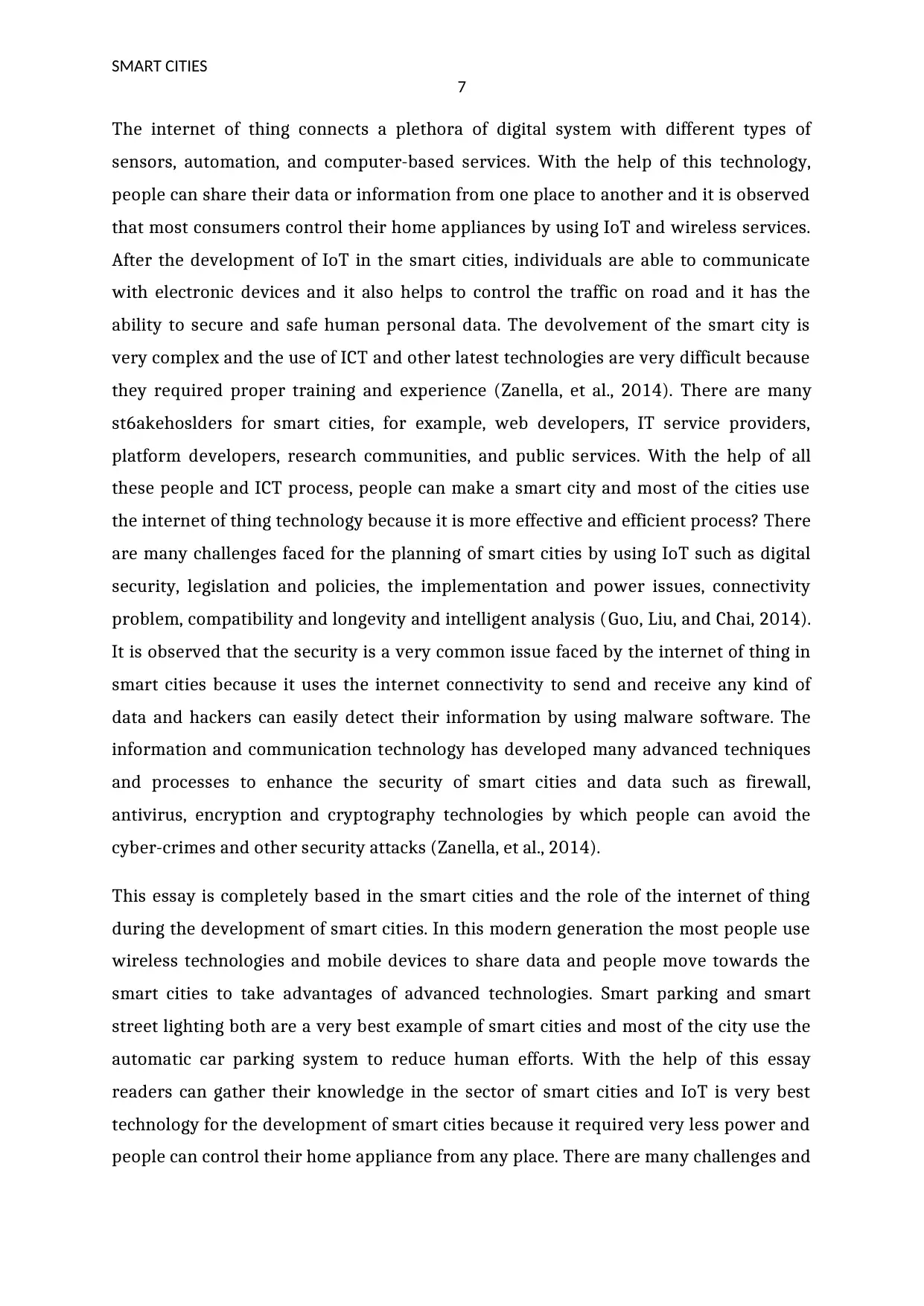
SMART CITIES
7
The internet of thing connects a plethora of digital system with different types of
sensors, automation, and computer-based services. With the help of this technology,
people can share their data or information from one place to another and it is observed
that most consumers control their home appliances by using IoT and wireless services.
After the development of IoT in the smart cities, individuals are able to communicate
with electronic devices and it also helps to control the traffic on road and it has the
ability to secure and safe human personal data. The devolvement of the smart city is
very complex and the use of ICT and other latest technologies are very difficult because
they required proper training and experience (Zanella, et al., 2014). There are many
st6akehoslders for smart cities, for example, web developers, IT service providers,
platform developers, research communities, and public services. With the help of all
these people and ICT process, people can make a smart city and most of the cities use
the internet of thing technology because it is more effective and efficient process? There
are many challenges faced for the planning of smart cities by using IoT such as digital
security, legislation and policies, the implementation and power issues, connectivity
problem, compatibility and longevity and intelligent analysis (Guo, Liu, and Chai, 2014).
It is observed that the security is a very common issue faced by the internet of thing in
smart cities because it uses the internet connectivity to send and receive any kind of
data and hackers can easily detect their information by using malware software. The
information and communication technology has developed many advanced techniques
and processes to enhance the security of smart cities and data such as firewall,
antivirus, encryption and cryptography technologies by which people can avoid the
cyber-crimes and other security attacks (Zanella, et al., 2014).
This essay is completely based in the smart cities and the role of the internet of thing
during the development of smart cities. In this modern generation the most people use
wireless technologies and mobile devices to share data and people move towards the
smart cities to take advantages of advanced technologies. Smart parking and smart
street lighting both are a very best example of smart cities and most of the city use the
automatic car parking system to reduce human efforts. With the help of this essay
readers can gather their knowledge in the sector of smart cities and IoT is very best
technology for the development of smart cities because it required very less power and
people can control their home appliance from any place. There are many challenges and
7
The internet of thing connects a plethora of digital system with different types of
sensors, automation, and computer-based services. With the help of this technology,
people can share their data or information from one place to another and it is observed
that most consumers control their home appliances by using IoT and wireless services.
After the development of IoT in the smart cities, individuals are able to communicate
with electronic devices and it also helps to control the traffic on road and it has the
ability to secure and safe human personal data. The devolvement of the smart city is
very complex and the use of ICT and other latest technologies are very difficult because
they required proper training and experience (Zanella, et al., 2014). There are many
st6akehoslders for smart cities, for example, web developers, IT service providers,
platform developers, research communities, and public services. With the help of all
these people and ICT process, people can make a smart city and most of the cities use
the internet of thing technology because it is more effective and efficient process? There
are many challenges faced for the planning of smart cities by using IoT such as digital
security, legislation and policies, the implementation and power issues, connectivity
problem, compatibility and longevity and intelligent analysis (Guo, Liu, and Chai, 2014).
It is observed that the security is a very common issue faced by the internet of thing in
smart cities because it uses the internet connectivity to send and receive any kind of
data and hackers can easily detect their information by using malware software. The
information and communication technology has developed many advanced techniques
and processes to enhance the security of smart cities and data such as firewall,
antivirus, encryption and cryptography technologies by which people can avoid the
cyber-crimes and other security attacks (Zanella, et al., 2014).
This essay is completely based in the smart cities and the role of the internet of thing
during the development of smart cities. In this modern generation the most people use
wireless technologies and mobile devices to share data and people move towards the
smart cities to take advantages of advanced technologies. Smart parking and smart
street lighting both are a very best example of smart cities and most of the city use the
automatic car parking system to reduce human efforts. With the help of this essay
readers can gather their knowledge in the sector of smart cities and IoT is very best
technology for the development of smart cities because it required very less power and
people can control their home appliance from any place. There are many challenges and

SMART CITIES
8
issues faced by the IoT in smart cities which are described in this essay and problem of
security can be avoided by adopting protection plans like firewall and encryption
process.
8
issues faced by the IoT in smart cities which are described in this essay and problem of
security can be avoided by adopting protection plans like firewall and encryption
process.
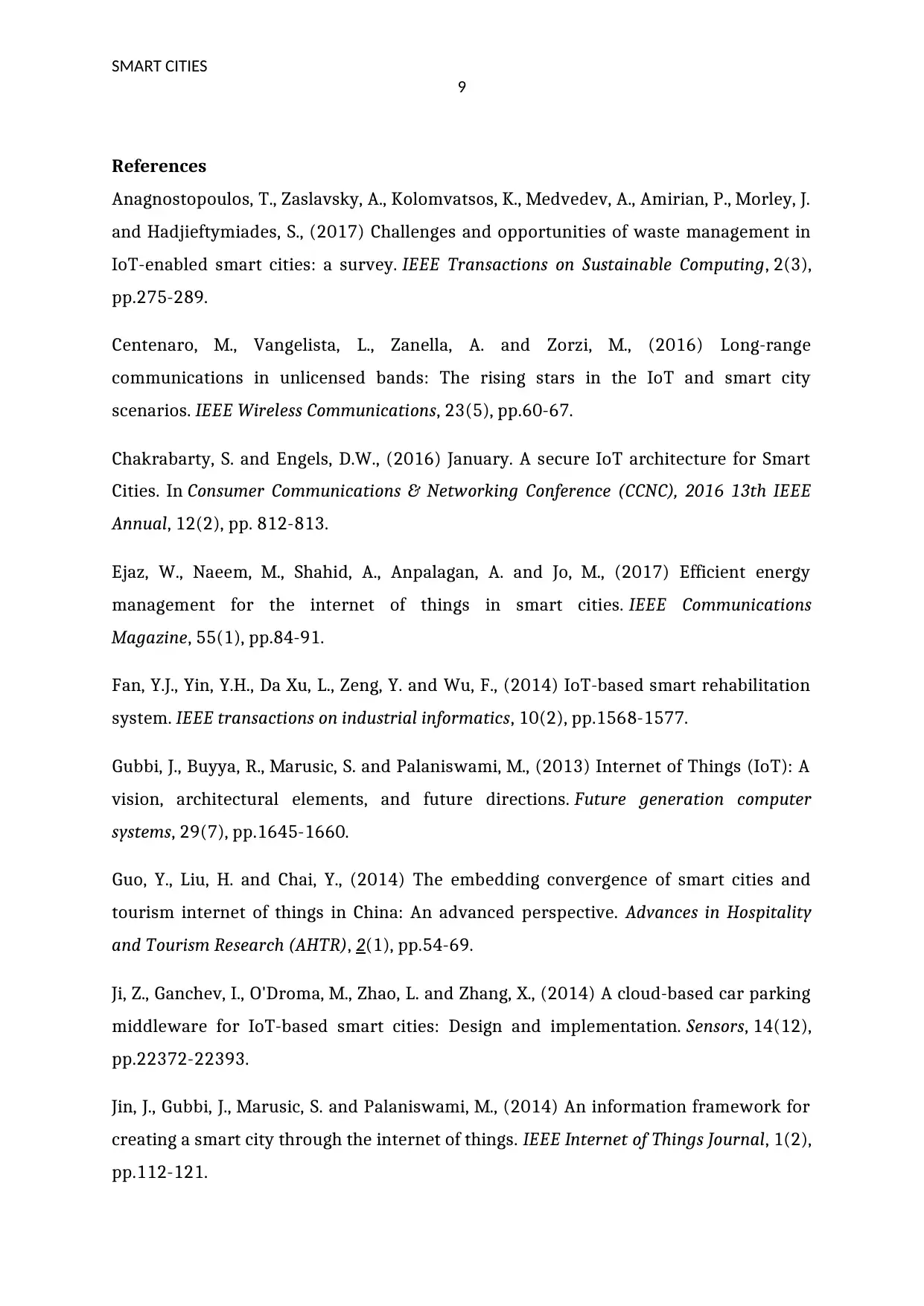
SMART CITIES
9
References
Anagnostopoulos, T., Zaslavsky, A., Kolomvatsos, K., Medvedev, A., Amirian, P., Morley, J.
and Hadjieftymiades, S., (2017) Challenges and opportunities of waste management in
IoT-enabled smart cities: a survey. IEEE Transactions on Sustainable Computing, 2(3),
pp.275-289.
Centenaro, M., Vangelista, L., Zanella, A. and Zorzi, M., (2016) Long-range
communications in unlicensed bands: The rising stars in the IoT and smart city
scenarios. IEEE Wireless Communications, 23(5), pp.60-67.
Chakrabarty, S. and Engels, D.W., (2016) January. A secure IoT architecture for Smart
Cities. In Consumer Communications & Networking Conference (CCNC), 2016 13th IEEE
Annual, 12(2), pp. 812-813.
Ejaz, W., Naeem, M., Shahid, A., Anpalagan, A. and Jo, M., (2017) Efficient energy
management for the internet of things in smart cities. IEEE Communications
Magazine, 55(1), pp.84-91.
Fan, Y.J., Yin, Y.H., Da Xu, L., Zeng, Y. and Wu, F., (2014) IoT-based smart rehabilitation
system. IEEE transactions on industrial informatics, 10(2), pp.1568-1577.
Gubbi, J., Buyya, R., Marusic, S. and Palaniswami, M., (2013) Internet of Things (IoT): A
vision, architectural elements, and future directions. Future generation computer
systems, 29(7), pp.1645-1660.
Guo, Y., Liu, H. and Chai, Y., (2014) The embedding convergence of smart cities and
tourism internet of things in China: An advanced perspective. Advances in Hospitality
and Tourism Research (AHTR), 2(1), pp.54-69.
Ji, Z., Ganchev, I., O'Droma, M., Zhao, L. and Zhang, X., (2014) A cloud-based car parking
middleware for IoT-based smart cities: Design and implementation. Sensors, 14(12),
pp.22372-22393.
Jin, J., Gubbi, J., Marusic, S. and Palaniswami, M., (2014) An information framework for
creating a smart city through the internet of things. IEEE Internet of Things Journal, 1(2),
pp.112-121.
9
References
Anagnostopoulos, T., Zaslavsky, A., Kolomvatsos, K., Medvedev, A., Amirian, P., Morley, J.
and Hadjieftymiades, S., (2017) Challenges and opportunities of waste management in
IoT-enabled smart cities: a survey. IEEE Transactions on Sustainable Computing, 2(3),
pp.275-289.
Centenaro, M., Vangelista, L., Zanella, A. and Zorzi, M., (2016) Long-range
communications in unlicensed bands: The rising stars in the IoT and smart city
scenarios. IEEE Wireless Communications, 23(5), pp.60-67.
Chakrabarty, S. and Engels, D.W., (2016) January. A secure IoT architecture for Smart
Cities. In Consumer Communications & Networking Conference (CCNC), 2016 13th IEEE
Annual, 12(2), pp. 812-813.
Ejaz, W., Naeem, M., Shahid, A., Anpalagan, A. and Jo, M., (2017) Efficient energy
management for the internet of things in smart cities. IEEE Communications
Magazine, 55(1), pp.84-91.
Fan, Y.J., Yin, Y.H., Da Xu, L., Zeng, Y. and Wu, F., (2014) IoT-based smart rehabilitation
system. IEEE transactions on industrial informatics, 10(2), pp.1568-1577.
Gubbi, J., Buyya, R., Marusic, S. and Palaniswami, M., (2013) Internet of Things (IoT): A
vision, architectural elements, and future directions. Future generation computer
systems, 29(7), pp.1645-1660.
Guo, Y., Liu, H. and Chai, Y., (2014) The embedding convergence of smart cities and
tourism internet of things in China: An advanced perspective. Advances in Hospitality
and Tourism Research (AHTR), 2(1), pp.54-69.
Ji, Z., Ganchev, I., O'Droma, M., Zhao, L. and Zhang, X., (2014) A cloud-based car parking
middleware for IoT-based smart cities: Design and implementation. Sensors, 14(12),
pp.22372-22393.
Jin, J., Gubbi, J., Marusic, S. and Palaniswami, M., (2014) An information framework for
creating a smart city through the internet of things. IEEE Internet of Things Journal, 1(2),
pp.112-121.
Secure Best Marks with AI Grader
Need help grading? Try our AI Grader for instant feedback on your assignments.
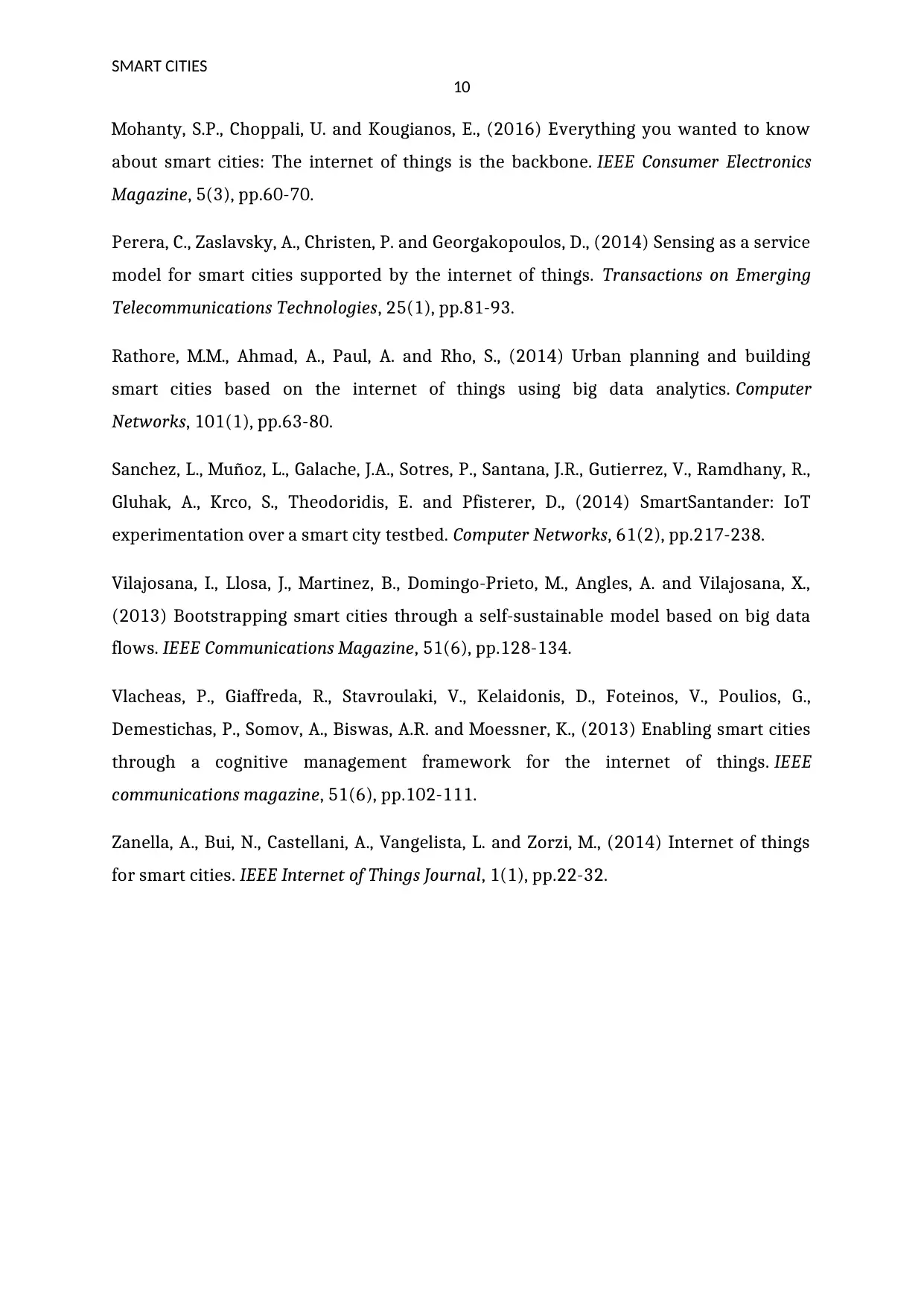
SMART CITIES
10
Mohanty, S.P., Choppali, U. and Kougianos, E., (2016) Everything you wanted to know
about smart cities: The internet of things is the backbone. IEEE Consumer Electronics
Magazine, 5(3), pp.60-70.
Perera, C., Zaslavsky, A., Christen, P. and Georgakopoulos, D., (2014) Sensing as a service
model for smart cities supported by the internet of things. Transactions on Emerging
Telecommunications Technologies, 25(1), pp.81-93.
Rathore, M.M., Ahmad, A., Paul, A. and Rho, S., (2014) Urban planning and building
smart cities based on the internet of things using big data analytics. Computer
Networks, 101(1), pp.63-80.
Sanchez, L., Muñoz, L., Galache, J.A., Sotres, P., Santana, J.R., Gutierrez, V., Ramdhany, R.,
Gluhak, A., Krco, S., Theodoridis, E. and Pfisterer, D., (2014) SmartSantander: IoT
experimentation over a smart city testbed. Computer Networks, 61(2), pp.217-238.
Vilajosana, I., Llosa, J., Martinez, B., Domingo-Prieto, M., Angles, A. and Vilajosana, X.,
(2013) Bootstrapping smart cities through a self-sustainable model based on big data
flows. IEEE Communications Magazine, 51(6), pp.128-134.
Vlacheas, P., Giaffreda, R., Stavroulaki, V., Kelaidonis, D., Foteinos, V., Poulios, G.,
Demestichas, P., Somov, A., Biswas, A.R. and Moessner, K., (2013) Enabling smart cities
through a cognitive management framework for the internet of things. IEEE
communications magazine, 51(6), pp.102-111.
Zanella, A., Bui, N., Castellani, A., Vangelista, L. and Zorzi, M., (2014) Internet of things
for smart cities. IEEE Internet of Things Journal, 1(1), pp.22-32.
10
Mohanty, S.P., Choppali, U. and Kougianos, E., (2016) Everything you wanted to know
about smart cities: The internet of things is the backbone. IEEE Consumer Electronics
Magazine, 5(3), pp.60-70.
Perera, C., Zaslavsky, A., Christen, P. and Georgakopoulos, D., (2014) Sensing as a service
model for smart cities supported by the internet of things. Transactions on Emerging
Telecommunications Technologies, 25(1), pp.81-93.
Rathore, M.M., Ahmad, A., Paul, A. and Rho, S., (2014) Urban planning and building
smart cities based on the internet of things using big data analytics. Computer
Networks, 101(1), pp.63-80.
Sanchez, L., Muñoz, L., Galache, J.A., Sotres, P., Santana, J.R., Gutierrez, V., Ramdhany, R.,
Gluhak, A., Krco, S., Theodoridis, E. and Pfisterer, D., (2014) SmartSantander: IoT
experimentation over a smart city testbed. Computer Networks, 61(2), pp.217-238.
Vilajosana, I., Llosa, J., Martinez, B., Domingo-Prieto, M., Angles, A. and Vilajosana, X.,
(2013) Bootstrapping smart cities through a self-sustainable model based on big data
flows. IEEE Communications Magazine, 51(6), pp.128-134.
Vlacheas, P., Giaffreda, R., Stavroulaki, V., Kelaidonis, D., Foteinos, V., Poulios, G.,
Demestichas, P., Somov, A., Biswas, A.R. and Moessner, K., (2013) Enabling smart cities
through a cognitive management framework for the internet of things. IEEE
communications magazine, 51(6), pp.102-111.
Zanella, A., Bui, N., Castellani, A., Vangelista, L. and Zorzi, M., (2014) Internet of things
for smart cities. IEEE Internet of Things Journal, 1(1), pp.22-32.
1 out of 11
Related Documents
Your All-in-One AI-Powered Toolkit for Academic Success.
+13062052269
info@desklib.com
Available 24*7 on WhatsApp / Email
![[object Object]](/_next/static/media/star-bottom.7253800d.svg)
Unlock your academic potential
© 2024 | Zucol Services PVT LTD | All rights reserved.



